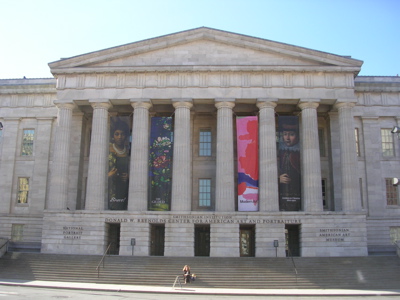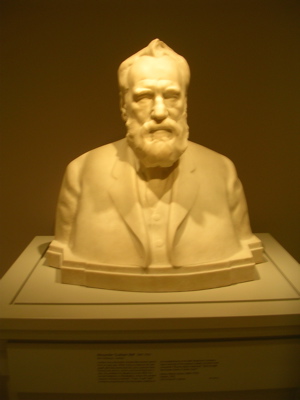
Portrait Gallery offers art history, education
WASHINGTON, D.C. — Walking down one of the halls in National Portrait Gallery, Andrea Johnson’s eyes shift from portrait to portrait behind her black-framed glasses. She walks slowly across the sleek marble floor and gives each work a solid minute of her attention, then moves on to the next.
“I think it’s important to understand your history and its importance,” said the 20-year-old Christian Ministries major from Azusa Pacific University. “I think that the portraits here are interesting. I like them because you get to read about them in history books and its good to put a face with the name.”
Our nation’s capital is full of historic monuments and landmarks that are visited day in and day out, whether it is for leisure or work. However, large portions of the visitors are there for educational purposes, such as college students wanting to find out more about the history of their country.
Located on 750 NW Ninth Street, in the heart of downtown, the National Portrait Gallery serves as a popular attraction to college students. Whether they are from the more than 20 colleges and universities from around the city area, or the thousands across the nation, students come to the gallery to, as Johnson put it, “put a face with the name.”
 |
The National Portrait Gallery building’s design takes on a Greek revival style that is unique. During the Civil War, it served as a hospital for the Union Army (Photo by Marcos Colón). |
Walking down the halls of the gallery, the portraits are organized chronologically from earlier periods to more recent.
“You can march through time in the form of a U,” Museum Public Affairs Specialist Bethany Bentley said.
The historic building actually hosts two museums, the Smithsonian National Portrait Gallery and the American Art Museum, which visitors can access both free of charge.
“You really walk through both museums when you visit,” Bentley said. “This building and these two museums hold some of the world’s best collections as far as history and art. This is a temple of invention. They represent American history, the faces of fame.”
Haley Dickinson, a 21-year-old graphic design major from Meredith College in Raleigh, N.C., traveled over four hours with other art majors from her school to the museum for the day.
“This place could help students appreciate art better,” she said. “There’s a monumental quality to everything here. Coming to a place like this could change one’s opinion about art.”
Individuals found in the gallery’s paintings and photographs range from dead presidents to iconic modern-day figures. In one room one can find a portrait of George Washington, while in another view a photograph of Shaquille O’Neal.
Prior to 2000, Bentley explained that there was a 10-year dead-rule for the museum which did not allow portraits or photographs of individuals who had not been deceased for at least 10 years in the museum.
“In 2000 the 10-year dead-rule was not in effect,” she said. “Now we are allowed to display living Americans.”
All though the majority of the individuals featured in the gallery are American, there are a significant number of historic Europeans figures pictured as well.
“You don’t have to be an American citizen to be in the gallery,” Bentley said. “You have to have been able to influence American culture in some way.”
One of the premier exhibits at the museum is ‘America’s Presidents,’ a complete collection of presidential portraits. Located near the end of ‘America’s Presidents’ is ‘President’s Hall,’ where portraits of recent presidents are found.
“The most notable exhibit we’re known for is ‘America’s Presidents,’” Bentley said. “Here we focused on five president’s because of their impact in the president’s office. President’s Hall was significantly expanded, now including modern presidents.”
The five presidents emphasized are George Washington, Andrew Jackson, Abraham Lincoln, Theodore Roosevelt and Franklin D. Roosevelt.
Upon entering ‘America’s Presidents,’ one can see Gilbert Stuart’s famous portrait of George Washington, “Lansdowne.” The portrait itself is large in size with a thick and grandiose gold frame. Next to the portrait, just like all the other historical works, is a brief description of the subject, George Washington, which gives background information such as his achievements and contributions to the nation.
Both young and old, all students are able to benefit from the art displaying prominent figures of America’s history. If the visitor’s are unfamiliar with the portrait, the description accompanying it is useful and educational.
Katherine Goodpasture, a fourth grade schoolteacher at Steward School in Richmond, Va., accompanied the entire fourth grade on a day-long educational trip to the museum. The school has given the kids an assignment that served as a history hunt throughout the gallery.
“The kids have to find political, sports and other famous figures,” Goodpasture said. “A portrait is an excellent way to learn about people. It’s easier for kids as well.”
Through these assignments, Goodpasture believes that the school is instilling historical knowledge into the students in a unique way. The assignments will be graded, which she believes will put more focus on the work.
“The kids have studied portraiture and some of the people in the portraits here,” she said. “The gallery is tremendous. It’s interesting to know how artists portray people in different ways.”
The museum has changed one important aspect that appeals to a younger audience.
“Something that we’ve done to attract a young crowd is change the hours,” Bentley said. “We’re open from 11:30 p.m. to 7 p.m., which is later than most museums.”
 |
Portrait sculptures, like this one of Alexander Graham Bell, are unexpected but are found throughout the Gallery (Photo by Marcos Colón). |
The building is also located in a very busy area of the city.
“We’re located in a very vibrant part of the city,” Bentley said. “So you can go to a bar or grab some dinner if you want.”
If the portraits in the museum aren’t enough, then the architecture is also a characteristic to be noticed.
The building, one of the earliest constructed in early Washington, D.C., was designed by various important American architects the most notable being Robert Mills. The design is considered a fine example of Greek revival architecture in the United States.
“The building process started in the early 19th century,” Bentley said. “The rooms that he (Robert Mills) designed have a cool classical look. This building really engages everyone.”
Sitting on one of the plush benches in the center of the gallery’s hall, Emre Ozdemir read a brochure on one of the current exhibits. Ozdemir, a student at the University of the Art in Philadelphia, was in town for the day and visiting the gallery for the first time.
“I first found out about this place from a brochure and after reading it I wasn’t too interested,” he said. “After deciding to come I’m really impressed.”
If You Go
- Hours: 11:30 a.m. to 7 p.m. daily. Closed on Dec. 25.
- Location: Located at Eighth and F Streets, NW, Washington, D.C., above the Gallery Place-Chinatown Metro Station (Red, Yellow and Green lines).
- Admission is free.
- Museum dining: Upper West Side Café open from 11:30 a.m. to 7 p.m., located on the third floor and offering sandwiches, salads and pastries.
- For information visit http://www.npg.si.edu call 202-633-8300 or e-mail npgnews@si.edu.

Comments are Closed